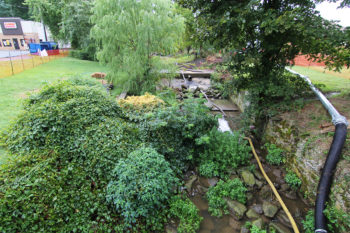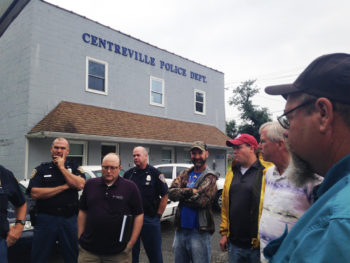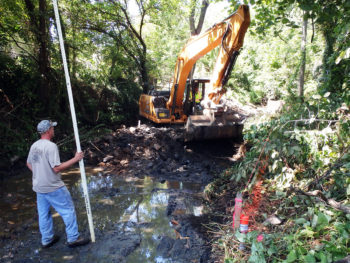Removal of Centreville Dam Kicks Off Today
Removal of the Centreville Dam on Maryland’s Eastern Shore begins in earnest this September. The project will reconnect fragmented river habitat for alewife, blueback herring, American eel and other migratory fish, as well as alleviate some potential for upstream flooding.
A hydraulic hammer pounding into the Centreville Dam heralds a coming new chapter for Gravel Run, a tributary to the Corsica River along Maryland’s Eastern Shore.
American Rivers is partnering with the Town of Centreville, Maryland Department of Natural Resources (DNR), U.S. Fish and Wildlife Service, and NOAA Restoration Center (NOAA) to remove the obsolete Centreville Dam and reconnect 13 miles of habitat for alewife and blueback herring, American eel, and yellow and white perch in an effort to improve their chance of survival and propagation.

Looking upstream at the Centreville Dam. The hose on the right is part of the pump system to dewater the work area.
“The U.S. Fish and Wildlife Service has been working for several years with American Rivers, Maryland DNR, and NOAA to identify dams in Maryland that are a priority for removal due to barriers to fish passage and risk to lives or infrastructure during high water events,” said Julie Devers, a fishery biologist with the U.S. Fish and Wildlife Service.
“Centreville Dam is one of the first dams that the group identified as a priority for removal using the Chesapeake Fish Passage Prioritization decision support tool. The collaborative effort to remove the dam will provide open access for blueback herring, alewife, and American eel to upstream habitat.”
Despite its small size, the Centreville Dam also exacerbates upstream flooding on Gravel Run, threatening local businesses and the police station located along its impoundment. As climate change threatens to increase incidents of flooding, we hope to improve local flood resiliency by removing the dam and restoring the natural stream channel and surrounding habitat.

The Centreville Police Station is located right along the river, and the sheriff and his officers came out to learn more about the planned work.
River restoration at this site entails more than just removing the Centreville Dam. Sitework began in mid-August when crews installed sandbags to stem the river’s flow and pumps to dewater the work area.
They also installed a rock ramp feature downstream in order to help fish navigate a downstream utility crossing and bridge, both of which needed to stay.
After the dam is removed, we will continue excavating out the historic river channel and will shore up the vegetative buffer with trees and shrubs that will provide additional shade habitat and protection against bank erosion. This work should wrap up in the next few weeks, and the site should be worth seeing by the fall harvest.

Crews excavate additional sediment out of the downstream channel as they prepare to build the rock ramp.
We would like to extend a special thanks to all of our funding partners.
We could not have made this happen without the financial support of the U.S. Fish and Wildlife Service funds from the Disaster Relief Appropriations Act of 2013 through the Department of the Interior, National Fish and Wildlife Foundation, Chesapeake Bay Trust, National Oceanic and Atmospheric Administration, and the Rauch Foundation.



